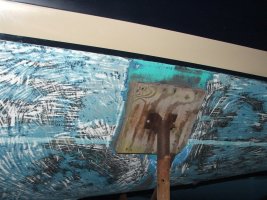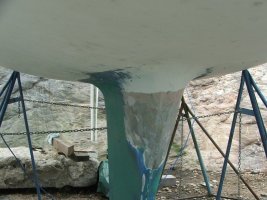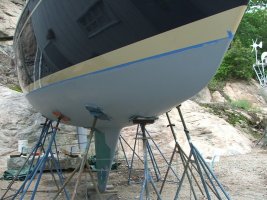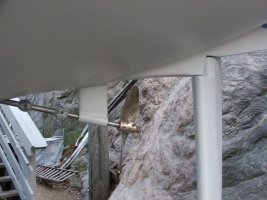Part 2
Early fiberglass boats were built over male molds, up side down. The inner layer of the glass was the first layer, the outer layer the last. As a rule, the last layer was woven roving, not mat. Gelcoat was applied last, as a finish. (The very early boats had no gelcoat at all. The hull was faired, sanded, and then painted) In some cases, especially with hard chine hulls, the hull was gelcoated and tightly wrapped with plastic. When the gelcoat was cured, the plastic was removed, and bingo, a smooth finish!
As building techniques progressed, hulls were built in female molds. It was discovered that the gelcoat could be applied first to the inside of the mold and then the layers of roving and mat were laid over that. It was soon discovered that, upon close examination, the pattern of the woven roving, which was adjacent to the gelcoat, would show, especially if the gelcoat was thin. This is called "print through".
This caused the manufacturers to reverse the procedure and put the mat next to the gelcoat instead of woven roving. (Mat has no pattern and a much finer texture) There is only one problem - the fibers in mat are held together with a starch like substance. I believe this to be the culprit of the blisters to some extent and the reason of the damage caused by the blisters to a great extent.
The general consensus amongst chemists is that when water migrates through the gelcoat and remains there for some time without circulation, (REMEMBER THIS) that a chemical reaction takes place which produces acid. It appears that the acid dissolves the starch like substance which in turn dislodges the resin and possibly evacuates this through the process of osmosis. In other words, it slowly disperses back out through the gelcoat to set up a balance with the surrounding water.
When the blister becomes the approximate size of a quarter, as a rule, when opened up, a small cavity can be seen in the outer laminate, which is the layer of mat. What one sees are the loose glass fibers, the resin is absent. Providing the boat was built properly in the first place, meaning same is not kept afloat on this layer of mat, in which case it would have broken up well before the blisters appear, these cavities do not weaken the structure.
I have never seen the woven roving affected by this process, which again proves the fact that it is the acid combined with the binding agent in the mat, and not the resin, which is the culprit.
Remember that in order for the chemical reaction to take place, the water has to have been trapped under the gelcoat for some time without circulation. It therefore follows that if the blisters are punctured at an early stage, before they have been able to cause any damage, there will be circulation, thus, the acid will not form or get to a stage where it can be harmful.
In any event, as I said, the damage, if any, is restricted to the outer layer of mat, which is not a structural component of the hull laminates anyhow and is there strictly for cosmetic purposes. In fact, many fiberglass boats have been built and repair jobs have been done, without a coating of gelcoat. Obviously, there is no need to spend a fortune by peeling layers of glass from the hull.
At most, to achieve a cosmetically pleasing appearance, the blister can be removed by sand blasting or grinding to remove the gelcoat, or by peeling of the gelcoat only, faired with filler and then sealed with any of the products readily available and suitable for that purpose. Or, otherwise, just grind the blisters off and paint!
Whatever you do, do not strip layers of laminates from the hull. This will structurally harm the vessel. There is no guarantee that the new layers applied will stick properly. In many cases where I have seen this done, the new layers are blistering, then you do have a problem because the hull laminates are now weakened!
A fiberglass hull does not absorb water. Core material, yes, but solid glass, no! Glass and resins are inert. There is no space for water. That plastic bucket that has contained water for many years, is as dry as a bone when the surface is wiped and dried. I put a humidity meter on a water bucket which my wife had used for many years in the paddock of her horse. I emptied it, gave it a good wipe and left in the sunshine for twenty minutes. The humidity reading was 5 percent, exactly the same as a brand new one.
It is often claimed that a hull has absorbed water and has therefore become heavier. These findings are based on readings with a humidity meter. Both statements are inaccurate. The humidity meter in the wrong hands is a dangerous instrument. The thing works by means of conductivity. The electrical current takes the shortest route through material with the least amount of resistance.
A humidity meter cannot be used over anti fouling paint because it is more conductive than fiberglass. Fire retardant resins cannot be metered for the same reason. Damp cloth, interior liners, paint, steel fuel tanks, water tanks, wooden frames and floors, if installed against or near the fiberglass measured, will throw the meter off scale. I started using a humidity meter in 1981, and I am still learning. Further more, what is often misunderstood is that the meter gives a reading of RELATIVE humidity. Not solid water content. Listen to the weather report, the announcer may state that the relative humidity is 65 percent. That does not mean that we are standing up to our necks in water. In fact, I was told by an employee of Sovereign Moisture Meters that when the meter's needle is at 100 percent, the actual water content is equivalent to one drop of water per cubic foot of fiberglass.
The question of weight is another mystery. The statement goes, "the glass has absorbed water and therefore has become heavier." In the first place, glass cannot absorb water, it could only absorb water if there was vacant space in the laminates. (poorly built and delaminated) or, if water has displaced those areas previously occupied by fiberglass. In other words due to some mysterious process, water has removed the fiberglass from the hull and taken its place.
Let's assume for argument's sake that this is possible. Water is now occupying space that was previously occupied by fiberglass. Well, it now becomes a question of specific gravity. All I know is that if I dump a piece of fiberglass in the ocean, it sinks like a stone. Yet, the water which I pour from a bucket seems to just sort of float around. To me that indicates that water is lighter than fiberglass. In other words, if I substituted portions of fiberglass from my boat with water, the boat should become lighter, never heavier!
Coatings of paint, epoxy and gelcoat will blister. Paint will blister on wooden boats and houses, epoxy coatings blister on steel and ferro cement boats, gelcoat will blister on fiberglass boats. What does all this mean?
When a boat has blisters, I find I have to depreciate its value, not because of her being unsound or unsafe, but due to misinformation. The general public will either not buy that boat, or expect a price reduction. The result? There are a lot of good boats out there which are going cheaply because they have blisters, but will provide the same enjoyment and are as safe as those with the smooth bottoms. For racing sailors, there is actually an advantage to having a boat with blisters. If they loose the race they can blame it on the blisters rather their sailing skill!
How long does fiberglass last? Nobody knows, it hasn't been around long enough. Perhaps my Grandfather can give us some idea. Not long ago I was in Grenada, West Indies. I was looking for an ex crew member of mine who had opened up a bar on Hog Island. I went there to look him up, but he had gone away on some errand.
As I stood waiting I scanned the boats in the anchorage. One sail boat looked awfully familiar. I borrowed a dinghy and went in for a closer look. I rowed around the boat and eventually could not stop myself from being rude and climbed on board. I checked her over pretty carefully and concluded she was in pretty good shape and obviously ready and trimmed to take her owners on the next leg of their voyage.
As I rowed away, I stopped to give her one last look. The yacht had swung away, showing her transom. On it was her name, it read, Josephine. "Not bad", I thought, "she is now almost fifty years old and she keeps going, and going, and going..."
About the Author








